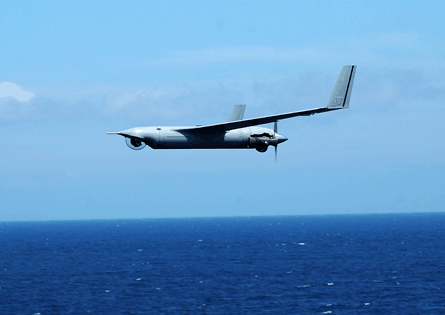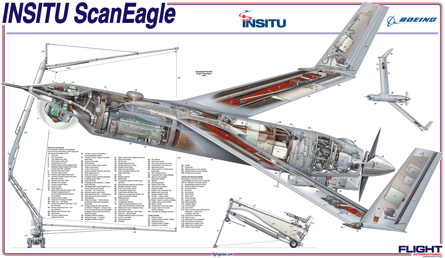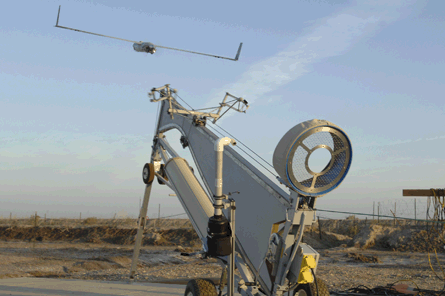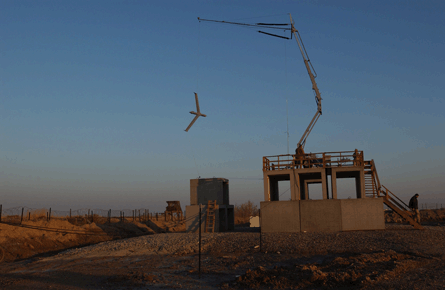It was 11 years ago when Insitu co-founder Tad McGeer received the telephone call that launched the unmanned air system that eventually became known as the ScanEagle.
Insitu had already demonstrated in 1998 that a low-altitude UAS could cross the Atlantic Ocean on a single flight. That one successful demonstration quickly attracted interest far beyond remote Bingen, Washington, the base for the then-small company of eight employees.
Insitu had traversed an ocean with an aircraft equipped to monitor weather data. But the flight raised what today may already seem a quaintly obvious question: instead of weather sensors, what if Insitu installed a camera in the nose of the air vehicle?
 |
|---|
© Insitu |
The idea did not spring from the military community. A few years - and the terrorist attacks on 11 September 2001 - would pass before the US armed services embraced the ability to persistently observe an area or even a precise spot for several hours. Rather, Insitu's founders fortuitously timed their idea immediately ahead of a decade-long, frenetic pursuit of unmanned aviation technology by military operators all over the world.
Within less than a decade, that sea-change in operational philosophy has turned the ScanEagle UAS into a globally ubiquitous piece of military kit. It also has stamped Insitu as a universally recognised brand, which since September 2008 has been wholly owned by Boeing.
DISRUPTIVE TECHNOLOGY
Along the way, the ScanEagle's now-proven technology successfully navigated the high barriers to entry into the US military acquisition system for a small company with no defence pedigree offering a disruptive technology.
As an operational system, the ScanEagle is credited for rapidly inventing and refining the now-standard operational role and profile for what the US Navy calls a small tactical UAS (STUAS) and what the US Marine Corps labels a Tier II UAS.
As a leased service, the ScanEagle has accumulated 175,000h of operational flying since 2004 and is adding another 10,000 flight hours every month.
Its larger and more capable successor - the Insitu Integrator UAS - is now competing for the STUAS/Tier II contract, a role defined largely by the experience and lessons accumulated over five years with the ScanEagle.
But the call that came to Insitu co-founder Tad McGeer in 1998 - true to the ScanEagle's inauspicious beginnings - came not from the military but instead from two consultants representing the tuna fishing fleets of the North Atlantic.
Their idea seemed logical. Insitu had already designed an unmanned aircraft to serve as an airborne weather observing station - or "aerosonde". Perhaps it could also design a UAV to serve as an airborne camera scanning just under the ocean surface for roving schools of tuna. This unmanned observing post would thus replace manned helicopters stationed on fishing boats for the same purpose.
"[The consultants] were able to convince Tad that [tuna boats] needed something like helicopters, but [the fisherman] absolutely hated them," says Jeff Knapp, Insitu's head of product development.
 |
|---|
Click on cutaway for fullsize image |
Moreover, highly competitive tuna fishing operators were also described as "early-adopters" of new technology, Knapp says, adding that this was a key requirement for McGeer. Insitu had struggled to sell UAS technology to risk-averse government agencies charged with weather observation for five years.
So McGeer tapped aerodynamicist Pere Frank - both alumni of fellow UAS pioneer Aurora Flight Sciences - to solve the unique challenges of operating from a fishing trawler, Knapp says. Insitu's design team faced more than the challenge of integrating a stabilised, off-axis, sensor turret to provide 360° surveillance coverage. Operating from the sea also involved the stressing task of launching and recovering the aircraft from a platform moving three-dimensionally in real time.
Insitu's novel engineering solution to the recovery problem, which includes a redesigned man-crane purchased at a local hardware store, is the patented SkyHook. The technology has been refined and improved over the past decade. But the basic approach, which involves patented navigation algorithms, nylon tether and wingtip hook, remains in service today among several naval customers, including the USN and Singapore.
"To us it's kind of a routine thing," says Erik Edsall, Insitu's business development director. "But some of our customers have trouble getting their heads around that recovery system."
The military would later prove that Insitu's unique technical solutions to sea-based challenges worked. But the tuna fishing trawlers that sparked Insitu's inspiration have yet to embrace the ScanEagle concept, which is branded for commercial customers as the SeaScan.
"That market didn't materialise," Knapp acknowledges. "For the tuna fisherman, it was really kind of a risk question in the end."
Fortunately perhaps for Insitu, the potential market for helicopter replacements on tuna trawlers would soon be overtaken unexpectedly by an all-new military requirement for airborne persistent surveillance.
Indeed, the market for unmanned aircraft capable of the military-level intelligence, surveillance and reconnaissance (ISR) mission evolved faster than anyone could have expected in the late 1990s.
By 2002, Boeing Integrated Defense Systems (IDS) was standing up a new organisation focused on unmanned systems, which was headed by Charlie Guthrie.
 |
|---|
"It was post-9/11," recalls Guthrie, now an executive at Insitu. "So there was kind of a big change going on across the military."
As an aerospace company based in Washington state, members of Insitu's 10-person staff in 2002 were already known by engineers within Boeing IDS, Guthrie says. Through those connections, he became aware that Insitu's offering for the fishing industry could be well-suited to the US military's still ill-defined need for unmanned surveillance.
"We thought, 'here's this little airplane that can go out and find tuna and we think this could go out and find targets for the US military'," says Guthrie, adding that Boeing executives considered it a "long shot. But it was a good long shot."
FIRST CUSTOMER
After a two-year sales campaign, the US Marine Corps signed up as the ScanEagle's first customer in 2004, Edsall says. The capability was urgently needed as a nascent insurgency continued to escalate in Iraq. There was no time to work through the Department of Defense's lengthy acquisition process. Indeed, five years later, the USMC and USN are only now close to signing the first standard acquisition contract for a ScanEagle-like capability.
Instead, the marines in 2004 did not acquire a system but a service. Boeing and Insitu formed four-person teams to deploy with the marines and operate the ScanEagle. Performance is measured not by sorties flown, but by availability for collecting imagery over a defined period.
"We are actually responsible for anywhere from 10, 15 sometimes 20-plus hours a day of guaranteed imagery support," Edsall says.
The USMC's service contract was followed a year later by a similar deal with the USN. The Australian Defence Force also deployed the ScanEagle in 2007. Singapore purchased the ScanEagle as a ship-based airborne imagery service in 2008. Canada signed a similar service deal last year, and followed by signing a full acquisition contract with Boeing/Insitu in April.
The 178mm (7in)-diameter ScanEagle design remains easily recognisable even as the market becomes crowded with similarly sized aircraft. Its graceful lines and 23° wing sweep still compares well visually to aircraft entering the market even years later.
Those defining characteristics are hallmarks of its intended purpose. The founders' goal was to design and configure the aircraft to cross the Pacific Ocean, Knapp says, having already conquered the North Atlantic.
Efficiency is the overriding principle of the design. Although the ScanEagle's commercial forebearer was intended to replace a ship-based helicopter, McGeer and Frank would never have even contemplated a rotary-winged platform.
"This thing has a glide ratio of 18:1," Knapp says. "A helicopter has a glide ratio of zero."
 |
|---|
© USAF |
The airframe structure bears the legacy most of all of Insitu's unique location. Bingen, on the Columbia River Gorge, is famous as a haven for windsurfers. The all-composite airframe was originally supplied by local surf board makers. Traditional aerospace suppliers, such as Quattro, have joined Insitu's composite structure supply chain in recent years, but local shops remain in the system.
The aircraft is powered by a German-made engine normally applied to lawnmowers, Edsall adds. The two-stroke engine generates 1.5hp (1.1kW), which is enough to keep the 20kg (9lb) airframe aloft for up to 22h on a standard day with standard temperature.
With an off-the-shelf Sony 1000 video camera - upgraded from the original Sony 780 model - as the primary daytime sensor, the Scan Eagle's "sweet spot" for surveillance is at a 2,500ft slant range from the target, Edsall says. This is the distance where it is practically invisible visually and acoustically from the ground, but still effective as an imagery collector.
"What we do to that Sony 1000 is we take it apart, put it in a specially gimballed turret," Edsall says. "We give it an off-axis, auto-track capability, add a lot of software stabilisation, platform stabilisation and come up with a capability that gives a near-seven, nears-eight-plus capability that comes with the [ground control station] and a geolocation accuracy that's comparable to about anyone else out there."
For nighttime and bad weather missions, the ScanEagle is now being upgraded from a long-wave infrared sensor to mid-wave, cooled IR camera, Edsall says, which corrects a recognised deficiency with the long-wave system.
Both the engine and the daytime sensor are typical of ScanEagle's component architecture.
"What we've done differently and part of the reason for our success is most of these pieces of kit in the ScanEagle system are commercial off-the-shelf [COTS] equipment," Edsall says. "They are things we bought off the shelf, added a little bit of 'secret sauce' and patented it. This makes the system affordable and easy to use and maintain."
There is no better example of this approach than the SkyHook recovery system.
"This SkyHook in its original manifestation was a Genie Lift mechanism that you could buy from the local Home Depot," Edsall says. "We hung a nylon rope from the boom off the top, put a GPS antenna on the air vehicle on the top of the boom and then patented the algorithm that we used for the GPS that allows guidance to a particular point on the wing where the nylon rope engages the wing within a couple of centimetres.
"That GPS algorithm is patented," Edsall adds. "When it engages the rope, the aircraft yaws at the point of impact. The rope gives, the rope flies to the end of the wing where a hook catches it. The hook is patented. The GPS [algorithm] is patented. We've taken some COTS kit, added some secret sauce, but this is not a real expensive mechanism at the end of the day and it's pretty flexible."
Concerns have been raised in the field about the size of the launcher equipment, Edsall says. Insitu is now in the process of developing a more powerful, but smaller, Mk4 launcher. The system was originally designed for the larger Integrator UAS. However, the same system can be used for ScanEagle. "It is smaller, but has more ability to get a heavier aircraft off the launch stroke," Edsall adds.
- All the latest news, images and video from the Paris Air Show
Source: Flight Daily News



















